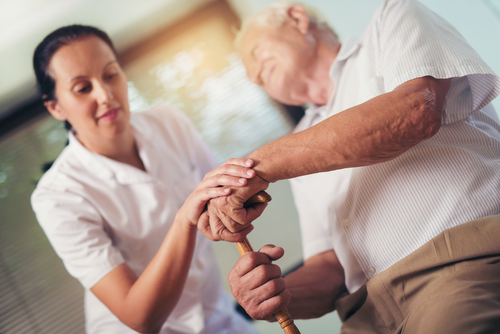Study Outlines Risk Factors for Frequent Falls in Parkinson’s Patients

Motor fluctuations, treatment with antidepressants, disease severity, and deep brain stimulation (DBS) are among the risk factors that contribute to frequent falls in patients with Parkinson’s, a large-scale study reports.
According to researchers, identifying predictors that put Parkinson’s patients at the greatest risk for falls can aid in early intervention to prevent these occurrences.
The study, “What predicts falls in Parkinson disease?” appeared in the journal Neurology: Clinical Practice.
Parkinson’s patients may experience falls as a result of their motor symptoms, such as uncontrollable accelerations, impaired balance, and freezing of gait. Approximately 50 percent of these falls require medical care.
Although a history of falling is considered the major risk factor for future falls, research reported that even individuals without any previous occurrences had a considerable risk of future falls. Other risk factors include disease stage and duration, older age, absence of tremor at rest, severity of motor impairment, cognitive dysfunction, taking antidepressants, and DBS — a surgical procedure to treat motor symptoms in Parkinson’s.
Discuss the latest research in the Parkinson’s News Today forums!
Recent studies also pinpointed dopaminergic treatment — intended to restore the reduced level of the neurotransmitter dopamine in Parkinson’s patients — disease severity, and gait characteristics, as well as clinical tests, as predictors of falls among patients without any previous history.
Researchers in this study analyzed longitudinal data from the National Parkinson Foundation Quality Improvement Initiative (NPF-QII) registry (NCT01629043) to discover what factors set apart Parkinson’s patients who are most likely to become frequent fallers.
The study included 3,795 participants from 19 NPF Centers of Excellence. A total of 3,276 (86.3%) patients reported no or rare falls in the three months prior to the first visit, of which 382 (11.7%) became frequent fallers by the annual follow-up visit. This rate is similar to those reported in prior studies, the researchers noted.
Predictors of falls included motor fluctuations, treatment with levodopa and antidepressants, DBS, reduced health-related quality of life, less than 90% of Parkinson’s diagnostic certainty, female sex, and worse semantic fluency (part of verbal fluency).
Another risk factor for falls was being a stage 2 or 3 on the Hoehn and Yahr scale — which is used to describe the progression of Parkinson’s symptoms, where stage 2 refers to bilateral involvement without impaired balance, and 3 to mild to moderate bilateral disease with postural instability but physical independence.
Regarding the association with antidepressants, the investigators said that although they are a known risk factor for falls in older adults and could indicate a greater incidence of depression — also a risk factor — clinicians should consider nonpharmacological alternatives to treat depression in Parkinson’s patients at risk of falling.
Between visits, factors contributing to conversion to “frequent faller status” included the addition of amantadine for involuntary muscle movements, a referral to occupational therapy, diagnoses of cancer or osteoarthritis, newly implemented DBS, and an increased need for social and hospital services, including more emergency visits, which may indicate poorer global health, the researchers said.
As for the correlation between DBS and the risk of falling, according to the authors, this finding is in line with evidence showing that postural instability and falls may worsen within the first year after surgery.
“We have identified a number of associations between disease characteristics, treatments, and comorbidities and emergent falls in [Parkinson’s],” they wrote. “Such identifiers may help target patient subgroups for falls prevention intervention.”
However, the scientists cautioned that although the analysis provides associations between risk factors and falls in Parkinson’s patients, it does not prove causality.
The NPF-QII registry is still recruiting participants for an estimated total of 10,000. It aims to identify the best expert care practices for improved outcomes, including survival and quality of life. The study is being conducted across the U.S., Canada, and in the Netherlands and Israel. More details on locations and contacts can be found here.






